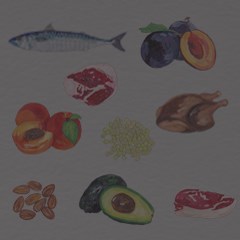Are rates of allergies increasing?
Definitely. I’m a gastroenterologist originally and moved into allergies to find out what all the fuss was about, and to get some expertise, but then I found that IgE-mediated food allergy was exploding in front of my eyes. There was an increase in allergies in the 90s, particularly asthma, hay fever and eczema. The second wave is the rise in food allergies, which has really happened since the 90s.
You’ve said you hope to turn the rates of allergies around. But why are they increasing?
The first thing is, you have to describe a problem, you have to predict what you think is causing it, then you describe a solution. So we’ve described the problem, we’ve predicted what we think is causing the problem, and we’re testing to see if we’re right, in small test populations. If those test populations support our hypotheses, then we will prescribe clinical guidelines and public health guidelines, what people need to do to prevent food allergy. So we’re starting to change guidelines based on our predictions, but we’re only half way through a number of predictive studies.
You and your colleagues are looking at what you call the “Five Ds” – diet, dry skin, dogs, dribble and Vitamin D – as possible explanations for this increase. Vitamin D?
The further from the equator you live, the more likely you are to have food allergies. And we also know that those who live further from the equator seem to have lower vitamin D levels. Australia has one of the highest rates of allergy in the world, and we are one of the few counties that doesn’t fortify our food chain with vitamin D. So the vitamin D hypothesis might be the sole reason why our rates of allergy are higher than other countries.
We’ve had an excellent “slip slop slap” campaign* in Australia, and people are living indoors more. People don’t get as much sun as they think. So while the anti-cancer campaigns have been fantastic at reducing rates of skin cancer, we need to understand the dark side, and maybe fortify our food with vitamin D.
And diet, dry skin, dogs and dribble?
Dry skin refers to eczema, which is on the rise, and we know that children with eczema are more likely to have food allergies – their immune system is being alerted and alarmed by exposure through broken skin. And we now also know now that if the introduction of certain foods into a baby’s diet is delayed, this increases risk of food allergy. Everyone is now pretty convinced that delaying the introduction of allergenic food such as peanut products, cow’s milk, wheat etc after the first year of life is harmful. The guidelines now are that solids should be introduced at six months, but not before four months, and that introducing allergenic foods within the first year of life will protect against food allergy.
Dogs and dribble pertain to the hygiene hypothesis, first described in 1989 in a landmark paper in the Lancet, which showed that the more siblings you had, the less hay fever you had. We’ve now published on this as well, and shown that dogs are also protective. Dogs represent the external microbiome – the importance of exposure to other bugs in the environment – whether through dogs, other children, or even exposure to microbes in the food or water supply. Dribble pertains to your own internal microbiome, how it trains the immune system. We have a trial that’s looking at trying to kick-start the immune system with an anti-TB vaccine.
We should maybe define what exactly an allergy is.
There are two types of food allergy – IgE-mediated allergy and non-IgE-mediated allergy [IgE refers to Immunoglobulin E]. Both involve an immunological response. IgE-mediated allergies are associated with anaphylaxis and the positive skin prick test, while non-IGE-mediated allergies are an adverse reaction to food, and mostly cause gut reactions. We mostly hear about IgE-mediated allergies, because they can kill you, while non-IgE-mediated allergies cause abdominal bloating, diahorrea or vomiting.
Lactose intolerance, for example, is a well-defined condition which makes it difficult for people to easily digest lactose, a natural sugar found in milk and other dairy products. It occurs because the enzyme lining of the intestine is missing, either congenitally (which is very rare) or as a secondary response to something else, such as a gastro virus or celiac disease, which damages the lining of the gut. About 98 percent of Asians and Africans develop lactose intolerance with age, presumably because they historically came from a non-milk dependent environment.
There was a widely circulated story about a boy who nearly died on the plane because someone in another row opened a packet of peanuts, and he had a severe anaphylactic response. Is air-borne peanut protein really that dangerous?
Food allergies are very common, but we eat a lot of food, we have a lot of encounters with food, and there are a lot of people eating lots of different food on planes, including nuts. The fact is that severe reactions are not a very common event, and for all intents and purposes, you do need to eat the food to have a serious reaction.
So should some foods just be banned in places like planes?
Food bans aren’t sensible. There are too many allergies to be able to protect people from other people eating allergenic foods in the plane. We don’t recommend banning foods on planes because you’d have to ban all foods, because people can be allergic to all foods that have protein. We recommend that airline staff are trained in how to recognize anaphylactic episodes and how to treat them, which is fair and reasonable and protective of people who are allergic.
Some schools try to ban peanut butter sandwiches – is that practical?
Nuts comprise about half of food allergies, and peanuts half of the nut allergies in the adolescent age group. But you can’t stop grandma making walnut cake, when someone might have a walnut allergy. Who’s going to check everyone’s lunch box? To fully understand what actually contains nuts, you’d have to educate every parent and every potential carer of every child, which becomes ridiculous and untenable. Early childcare centers are different, because children do share and smear food. But once the child goes to school the child should know they shouldn’t share food. That is a standard, universal precaution for all children, to protect them from all sorts of conditions. But you’re not going to have an anaphylactic episode because you’ve sat on someone else’s peanut butter sandwich.
The condition we hear most about, perhaps, is gluten sensitivity – is it as prevalent as it seems?
The thing with these gastrointestinal food allergies is that the symptoms are fairly common and can be caused by all kinds of food and for all sorts of reasons. So there is over-diagnosis, under diagnosis, and misdiagnosis of gluten-sensitivity.
There are a lot of people who are having symptoms that are related to the gastrointestinal tract, who think they have gluten intolerance and feel better off without it. It’s a fairly benign thing to do to your diet. As long as they’re not imposing it on children at a high point of growth, and not interfering with that growth, as long as they’re not doing harm to themselves and it’s not too expensive for them, then we should respect their choices.
I had a friend recently diagnosed with celiac disease who came to stay, but wouldn’t use our toaster because our bread crumbs might contaminate her gluten-free toast. Should this have annoyed me?
People have particular sensitivities about what they will and won’t eat. Some of them are health-based and some of them aren’t. There are some people who, if they get a few crumbs of gluten on their toast, it will give them a gastrointestinal upset – and why should she suffer from that? But some people like to make a fuss about things. Some people who don’t have food allergies will make a fuss about other things to do with food, such as whether it’s organic food, or the best quality food, or whether it came in a plastic bag. We all have to eat, and people seem to have quite quirky views about food. Human beings are complicated.
* Slip on a shirt, Slop on sunscreen, Slap on a hat has been a successful advertising slogan used in New Zealand and Australia, to reduce rates of skin cancer. In Australia this has reduced rates of some skin cancers (but not melanoma), but has been linked to increased rates of Vitamin D deficiency.

Professor Katie Allen is the Theme Director of Population Health and Group Leader of Gastro and Food Allergy at Murdoch Children’s Research Institute in Melbourne, Australia. She is a pediatric gastroenterologist and allergist undertaking research in the evolving field of food allergy, and her vision is to prevent food allergy in Australian children.







